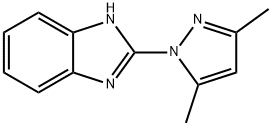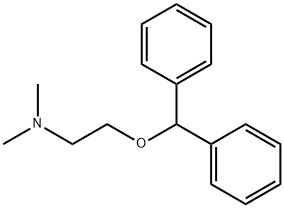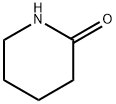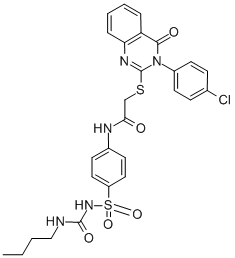carbutamide
- CAS NO.:339-43-5
- Empirical Formula: C11H17N3O3S
- Molecular Weight: 271.34
- MDL number: MFCD00025344
- EINECS: 206-424-4
- SAFETY DATA SHEET (SDS)
- Update Date: 2024-12-18 14:08:57

What is carbutamide?
Chemical properties
Off-White to Pale Peach Solid
Originator
Carbutamide,Servier
The Uses of carbutamide
Antidiabetic.
What are the applications of Application
4-amino-N-[(butylamino)carbonyl]benzenesulfonamide is a useful antidiabetic compound in vitro
Definition
ChEBI: Carbutamide is a sulfonamide and a member of benzenes.
Manufacturing Process
223 g of the sodium salt of acetylsulfaniamide are stirred with 223 ml of
triethylene glycol. 118 g of n-butyl isothiocyanate are added to the resulting
homogeneous mixture. The resulting syrup is heated to 85°C for 4 hours. The
mixture is then stirred with 1000 ml of chloroform and 1000 ml of water. The
chloroform layer is twice shaken with water, each time with 250 ml. The
aqueous extracts are combined and rendered weakly alkaline to
phenolphthalein by addition of hydrochloric acid. Unreacted acetyl
sulfanilamide precipitates and filtered off. The filtrate is acidified to a pH of
6.5 by the addition of HCl. An oily precipitate settles from the reaction
solution and is separated therefrom. N-Butyl acetyl sulfanilylthiourea is
precipitated from mother liquors obtained thereby by addition of HCl until
Congo paper changes its color to blue. 210 g N-butyl acetyl sulfanilylthiourea
are dissolved in 1400 ml of acetone while heating. The solution is mixed with
500 ml of water. A solution of 63 g of sodium nitrite in 120 ml of water is
added thereto within about 45 minutes while stirring and cooling to 15°-20°C.
A suspension of crystals is obtained. 240 ml of 25% glacial acid are added
thereto within 30 minutes. Stirring of the mixture is continued for 6 hours. N-Butyl acetyl sulfanilylurea mixed with sulfur is precipitated and filtered off. The
crude reaction product is suspended in 1000 ml of water and is rendered
weakly alkaline to phenolphthalein. Undissolved sulfur is filtered off. The
filtrate is acidified by the addition of HCl. 250 g of N-butyl acetyl
sulfanilylthiourea having a melting point of 186°-189°C are obtained. It is
heated with 500 ml of 5 N potassium hydroxide solution to a temperature of
92°C for 2 hours while stirring. The solid reaction product is dissolved by
heating with 750 ml of water and is purified by means of activated charcoal.
The resulting solution is heated to 60°C and acidified by addition of HCl. 187 g
of N-butyl acetyl sulfanilylthiourea melting at 139°-141°C obtained thereby.
Therapeutic Function
Oral hypoglycemic
Safety Profile
A poison by intraperitoneal route. Moderately toxic by ingestion and subcutaneous routes. An experimental teratogen. Other experimental reproductive effects. When heated to decomposition it emits very toxic fumes of NO, and SOx.
Properties of carbutamide
| Melting point: | 144-145° |
| Density | 1.2840 (rough estimate) |
| refractive index | 1.6630 (estimate) |
| storage temp. | Refrigerator |
| solubility | DMSO (Slightly), Methanol (Slightly) |
| pka | pKa 5.75(H2O t=25±0.02 I=0.2) (Uncertain) |
| form | Solid |
| color | Off-White to Pale Beige |
| Water Solubility | 535.2mg/L(37 ºC) |
| EPA Substance Registry System | Benzenesulfonamide, 4-amino-N-[(butylamino)carbonyl]- (339-43-5) |
Safety information for carbutamide
| Signal word | Warning |
| Pictogram(s) |
 Exclamation Mark Irritant GHS07 |
| GHS Hazard Statements |
H315:Skin corrosion/irritation H319:Serious eye damage/eye irritation H335:Specific target organ toxicity, single exposure;Respiratory tract irritation |
| Precautionary Statement Codes |
P261:Avoid breathing dust/fume/gas/mist/vapours/spray. P264:Wash hands thoroughly after handling. P264:Wash skin thouroughly after handling. P271:Use only outdoors or in a well-ventilated area. P280:Wear protective gloves/protective clothing/eye protection/face protection. P312:Call a POISON CENTER or doctor/physician if you feel unwell. P362:Take off contaminated clothing and wash before reuse. P302+P352:IF ON SKIN: wash with plenty of soap and water. P304+P340:IF INHALED: Remove victim to fresh air and Keep at rest in a position comfortable for breathing. P305+P351+P338:IF IN EYES: Rinse cautiously with water for several minutes. Remove contact lenses, if present and easy to do. Continuerinsing. P403+P233:Store in a well-ventilated place. Keep container tightly closed. P501:Dispose of contents/container to..… |
Computed Descriptors for carbutamide
New Products
(S)-3-Aminobutanenitrile hydrochloride 4-Methylphenylacetic acid N-Boc-D-alaninol N-BOC-D/L-ALANINOL Tert-butyl bis(2-chloroethyl)carbamate 3-Morpholino-1-(4-nitrophenyl)-5,6-dihydropyridin- 2(1H)-one Furan-2,5-Dicarboxylic Acid Tropic acid 1-Bromo-3,5-Di-Tert-Butylbenzene S-2-CHLORO PROPIONIC ACID ETHYL ISOCYANOACETATE 2-Bromo-1,3-Bis(Dimethylamino)Trimethinium Hexafluorophosphate 4-IODO BENZOIC ACID 3-NITRO-2-METHYL ANILINE 1-(2,4-DICHLOROPHENYL) ETHANAMINE (2-Hydroxyphenyl)acetonitrile 4-Bromopyrazole 2-(Cyanocyclohexyl)acetic acid 4-methoxy-3,5-dinitropyridine 1-(4-(aminomethyl)benzyl)urea hydrochloride 2-aminopropyl benzoate hydrochloride diethyl 2-(2-((tertbutoxycarbonyl)amino) ethyl)malonate tert-butyl 4- (ureidomethyl)benzylcarbamate Ethyl-2-chloro((4-methoxyphenyl)hydrazono)acetateRelated products of tetrahydrofuran








You may like
-
 N1-(BUTYLCARBAMOYL)-SULFANILAMIDE CAS 339-43-5View Details
N1-(BUTYLCARBAMOYL)-SULFANILAMIDE CAS 339-43-5View Details
339-43-5 -
 2033-24-1 98%View Details
2033-24-1 98%View Details
2033-24-1 -
 1975-50-4 98%View Details
1975-50-4 98%View Details
1975-50-4 -
 2-HYDROXY BENZYL ALCOHOL 98%View Details
2-HYDROXY BENZYL ALCOHOL 98%View Details
90-01-7 -
 2-Chloro-1,3-Bis(Dimethylamino)Trimethinium Hexafluorophosphate 221615-75-4 98%View Details
2-Chloro-1,3-Bis(Dimethylamino)Trimethinium Hexafluorophosphate 221615-75-4 98%View Details
221615-75-4 -
 61397-56-6 CIS BROMO BENZOATE 98%View Details
61397-56-6 CIS BROMO BENZOATE 98%View Details
61397-56-6 -
 14714-50-2 (2-Hydroxyphenyl)acetonitrile 98+View Details
14714-50-2 (2-Hydroxyphenyl)acetonitrile 98+View Details
14714-50-2 -
 118753-70-1 98+View Details
118753-70-1 98+View Details
118753-70-1